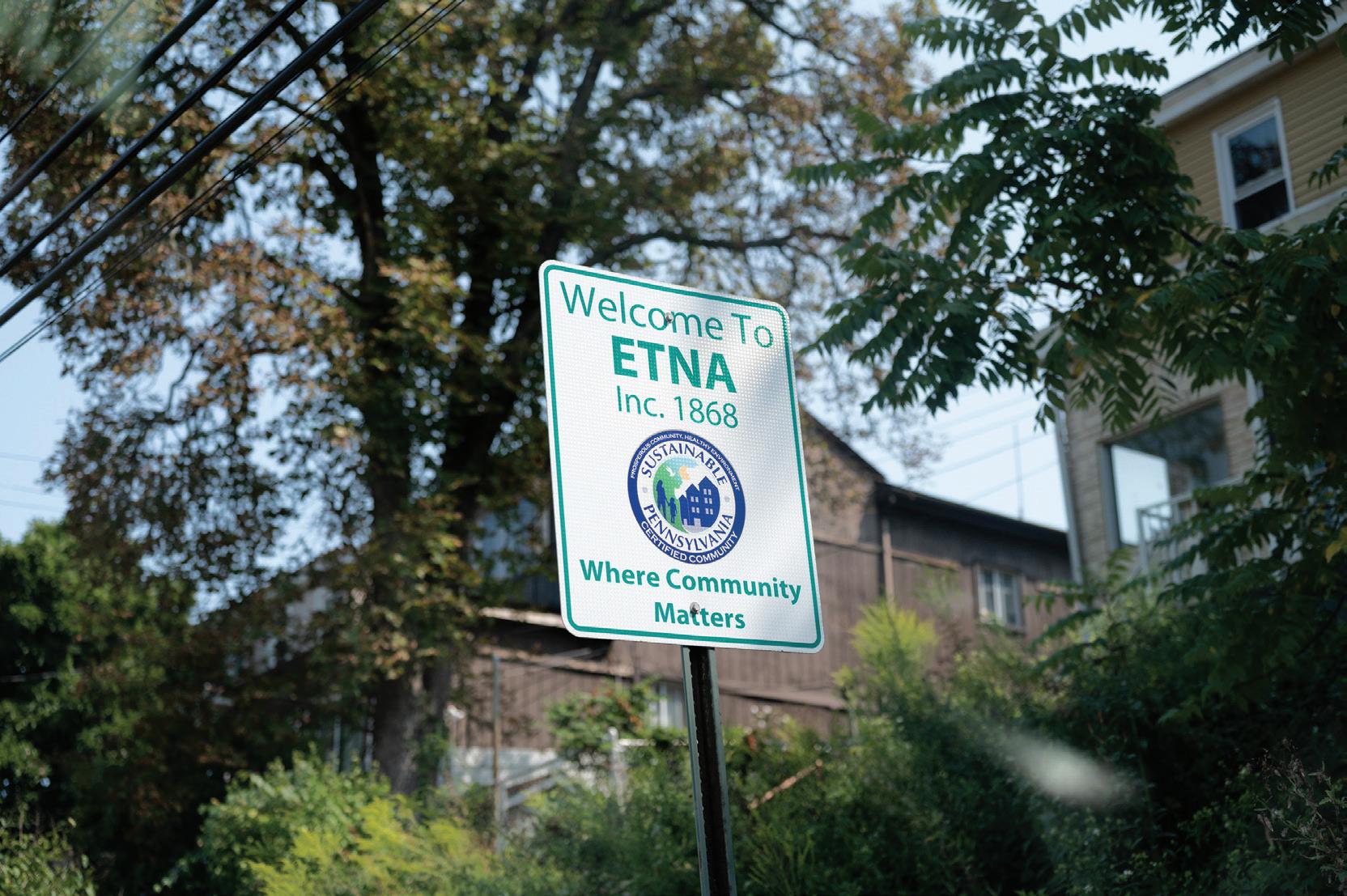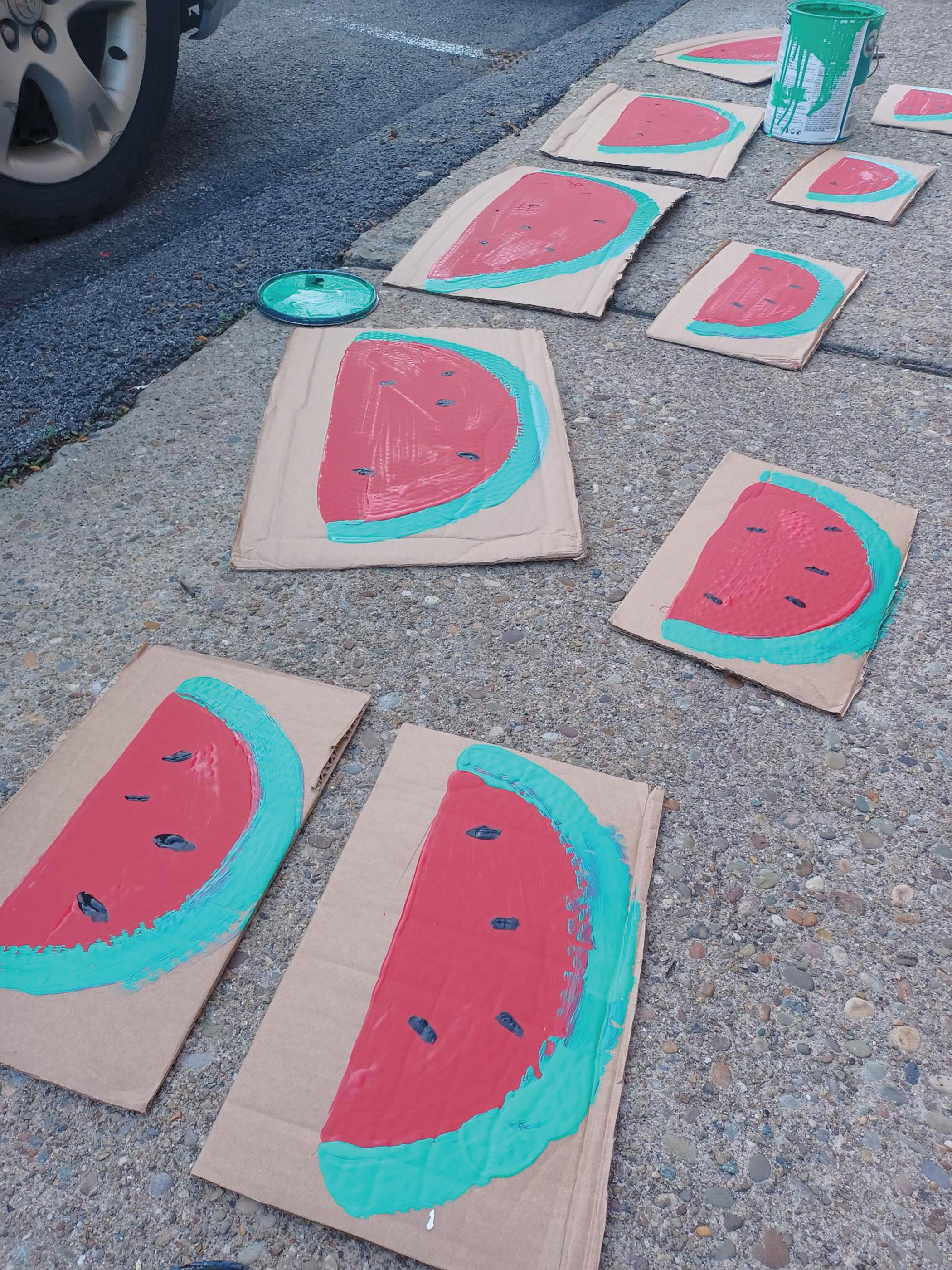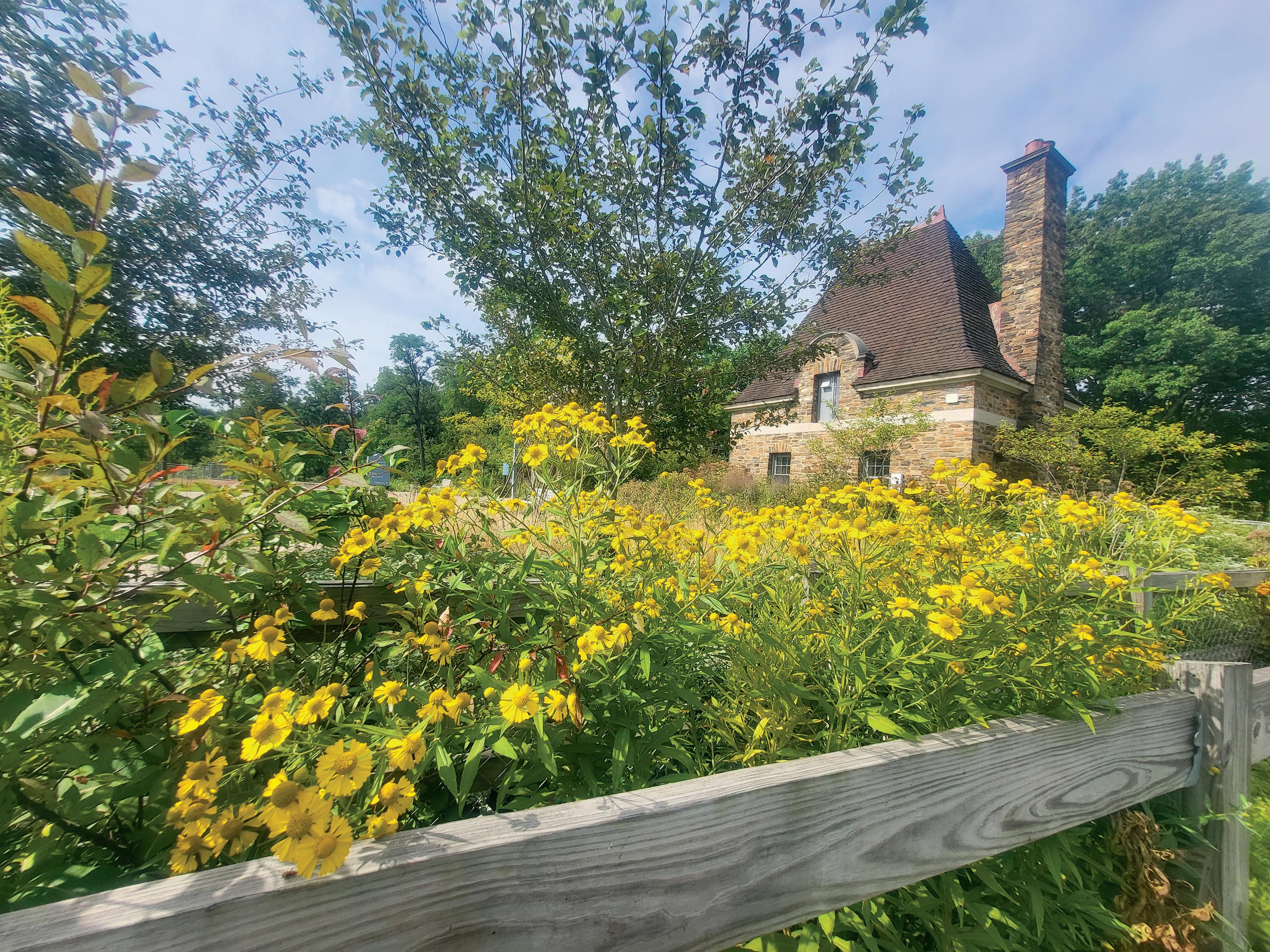




COLIN WILLIAMS

GRACE DELALLO



RACHEL BAILEY

MATT PETRAS

















COLIN WILLIAMS

GRACE DELALLO



RACHEL BAILEY

MATT PETRAS











Etna is a case study in how global political issues — and unexpected media attention — can complicate local politics and test bonds among neighbors
BY: COLIN WILLIAMS // CWILLIAMS@PGHCITYPAPER.COM
“THE COUNCIL FINDS A NEED TO ESTABLISH A FORMAL POLICY TO RESTRICT ITS OWN DELIBERATIONS ON MATTERS THAT ARE OUTSIDE OF ITS LOCAL RESPONSIBILITY.”
It doesn’t take long for politics to get purple outside of Pittsburgh city limits. While the boroughs across the river, including former steel town Etna, lean more liberal, the more rural areas, including nearby Shaler, tend to house more Republican voters. Like its neighbors Millvale and Sharpsburg, Etna is in the process of a glow-up. New residents, new gastronomy, and new ideas have invigorated the borough.
However, an April Gaza ceasefire resolution — and significant backlash to it from some borough residents, non-residents, and outside advocacy groups, compounded with attention from a national conservative media outlet — has revealed some finer fissures beneath the surface.
The borough council, which unanimously passed the April resolution, has since passed a further resolution limiting the scope of future bills beyond the borough’s purview. The council has also fallen behind on posting minutes from borough meetings, though Pittsburgh City Paper could not firmly establish why by presstime.
Multiple sources say the months of back-and-forth and unwanted attention has created lingering tension. In stark contrast to the community uniting against a resident flying a Nazi flag in 2022, Etna has found itself confounded by how to handle differing beliefs about the ongoing violence in the Gaza Strip.
•
Peaceful protests have taken place regularly in Greater Pittsburgh since the war in Gaza began following Hamas’ deadly Oct. 7 attack on Israel and the seizing of more than 200 hostages. But the tone of demonstrations became more urgent through the spring, as CP has documented.
Etna resident Judith Koch says borough residents supporting a ceasefire in Gaza began discussing the issue shortly after Allegheny County failed to pass a ceasefire resolution in March. County Councilmembers including Bethany Hallam, with support from Jewish activists supporting a ceasefire, had put forward the resolution to send a message to the federal government. Koch and others were frustrated by the county’s “no” vote and decided to reapproach the issue locally.
Koch, who moved to the U.S. from Germany, says she feels bound by her heritage to speak up. “I am one generation removed from my people committing the Holocaust,” Koch told the borough council during a summer meeting. “It’s a very difficult place to be when you’re growing up.”
Nicole Semple, another resident who has been active in calling for a ceasefire, wrote council at the time, “You might not think that a resolution in a small borough like ours makes a difference, but we must play our part for the greater good.”
“There was a bit of a discussion
about the impact of a resolution passed by Etna council would have (as in that Etna has no say in a matter of overseas conflict) and to make sure the Etna Jewish community will have a say,” Koch writes in an email, “but everyone agreed to have a draft ceasefire resolution ready for [the] next council meeting.”
In stark contrast to the Allegheny County resolution, the Etna ceasefire resolution passed council unanimously on Apr. 16 following emotional public comment from Koch and others, including two Jewish Etna residents. The resolution condemned Hamas and antisemitism while calling for federal action to support a ceasefire. Photos show residents, alongside Etna borough councilors Jessica Semler and Alice Gabriel, holding hand-painted watermelon signs (the watermelon has become a popular symbol of support for Palestinian freedom).
“Our ceasefire resolution exists because over two dozen of our neighbors emailed, wrote, and called us asking us to pass a local resolution,” Semler writes CP in a statement. Semler says the residents who spoke up have been some of the most involved in community projects including the garden, the Etna Community Organization (ECO), and the planned library. “Imagine if the billions of federal tax dollars we earmark for war each year went into our communities instead.”
• This hopeful unanimity ended when media involvement changed the dynamic of the discussions.
The Pittsburgh Jewish Chronicle , which attended the borough council meeting, depicted a “chaotic and confused conversation,” noting that borough council president Dave Becki had asked more than once if other council members wanted to table the resolution to give residents more time to consider it. Following addition of language urging the safe return of the hostages Hamas took after Oct. 7, the resolution passed anyway.
Etna Mayor Robert Tuñón, the Jewish Chronicle notes, was the only person to speak up against the resolution, calling it “divisive.”
Tuñón nonetheless says he respects the borough’s final vote. “I am very proud of our community for its civic engagement, the ways that our residents and businesses take great interest in what happens in our community, and the ways that people stand up for what they believe in,” he tells CP via email. “This civic engagement is one of the reasons that Etna is such a resilient community.” Tuñón and his wife, Megan, who serves as a borough councilmember, have both also been extensively involved with ECO, the library, and other community projects.
Koch says she didn’t experience any pushback except Tuñón’s — this,

however, changed with the publication of the Chronicle story.
“The small group of residents I organized with … agreed that we would not make any social media posts or discuss the resolution outside the community,” she writes. “When the Jewish Chronicle article was published, that is when council started getting a lot of emails, and I saw some social media discussion.”
Julie Paris, mid-Atlantic regional director of StandWithUs, a proIsrael advocacy organization, says the Chronicle article was how she
learned of the resolution. Paris was one of the speakers on a controversial January fundraising call with failed U.S. Congressional candidate Bhavini Patel and has been extensively quoted in the Chronicle and other media for her recent activism.
and Israel,” Paris tells CP via email.
“In some cases, this means issuing symbolic condemnations of Israel or supporting a ‘ceasefire’ that would leave Hamas in control of Gaza and often ignores the hostages.”
Paris, like many in the Jewish
“I JUST DON’T WANT MONEY GOING TO BOMBS THAT RIP CHILDREN INTO PIECES.”
“There has been intense pressure on many local governments to pass one-sided legislation regarding the Oct. 7 war between Hamas
community and beyond, says she’s concerned by the well-documented global rise in antisemitism. As of Aug. 30, she had continued to email
borough personnel to deplore antisemitism and seek a retraction of the initial ceasefire resolution.
As a non-Etna resident, however, Paris could not speak during borough meetings (Paris tells CP that she is “a resident of the region”), but she served as a primary source in the media attention that followed the legislation.
In a May 28 story from the national conservative outlet the Washington Examiner , right-leaning journalist Salena Zito warns readers that a “Far-left, pro-Palestinian movement is coming to a small town near you.” Zito’s article , which quotes Paris and tracks the development of the ceasefire resolution, uses an Instagram photo of councilmember Semler and county councilperson Hallam without permission, Semler says.
The second entry came again from Chronicle reporter David Rullo, again with substantial commentary from Paris. The paper’s May 29 article reported that “more than 40 people wrote letters to Etna council members expressing their frustration with the vote,” though Rullo did not note if these were from within the borough. During the May 21 borough meeting, “approximately six people spoke against the resolution and another four or five spoke in favor of the call for a ceasefire [sic],” per the Chronicle. The article also states that Paris “coordinated the pro-Israel community’s response to the initial vote.”
The deluge of letters, (all of which were read aloud), negative


media attention, and public dissent from others including Ketchup City Creative owner Nanci Goldberg (who initially responded to CP ’s request for comment but did not answer further questions), caused the borough council to press pause on sending their resolution to the federal government.
Sources tell CP that anonymous people opposed to the resolution called the employers of at least two of the resolution’s supporters in a bid to get them fired. Meanwhile, several sources for this story also tell CP the back-and-forth around the resolution began to create rifts among neighbors. One source says the tension made them feel uncomfortable participating in community initiatives such as the Garden of Etna.
Borough council president Dave Becki denies the disagreement has impacted these projects in a material way. “The garden and the future library are testaments to the hard work and dedication of the Borough and residents who collaborate daily to enhance the quality of life in our community,” Becki tells CP via email.
By late summer, even some of the borough councilmembers who
initially supported the ceasefire resolution — including Becki, who voted for it, and Gabriel, who co-wrote it with Semler — essentially said they had overstepped. Others, including Semler, held the increasingly lonely line as community members, including Koch, continued to speak out.
•
The Aug. 20 borough meeting found Etna residents on both sides of the issue at something of a crossroads.
On the agenda were the typical matters of local government. Should the borough increase crossing-guard pay? How would Etna pay for the renovation of a historic building? What would be the best way to make traffic safer while adding parking?
The meeting, held before a full house at a dais adorned with Etna’s seal, which depicts an exploding volcano, featured only one official item related to the ceasefire initiative: a resolution on resolutions.
“The Council finds a need to establish a formal policy to restrict its own deliberations on matters that are outside of its local policymaking responsibility,” the brief new



resolution reads in part.
“This resolution was developed in response to some of your requests, some of your concerns,” Becki told those assembled, so that “in the future, we all follow the same game plan when it comes to resolutions.”
Megan Tuñón motioned to adopt the resolution. With it seconded, the motion passed on a 5-3 vote, with Semler and councilmembers Bradley Iannuzzi and Danielle RothmeyerMcElhaney dissenting, the latter seemingly because of the resolution’s lack of specifics.
During public comment, Koch and other ceasefire supporters spoke again. “No one is giving me talking points on this,” Koch told council while draped in a rainbow keffiyeh.
“I’ve been an activist since I was a teenager, and I guess that was news for some people.” She says a re-explo ration of her family in Germany’s resistance to the Nazis and a strong drive to avoid repeats of history prompted her to continue speaking.
“I just don’t want money going to bombs that rip children into pieces,” she said.
Jesse Dubin, an Etna resident who holds a Jewish identity, questioned how council would enforce such a resolution. “Do we have a process now in place for determining if some thing is within the council’s purview or jurisdiction?” they wondered. “If it ain’t broke, should we be spending time fixing it?” Others chimed in to wonder the same.

Becki seemed unclear on an actual procedure for following the new guidelines. “We will discuss that among ourselves, maybe one on one, one on two,” he told Dubin. “We’re trying to lay some guidelines to prevent too many conversations on issues we have no control over.”
The meeting adjourned with some frustrated and others seemingly relieved. Attendees shared a few grumblings and uneasy jokes. While there was a clear aesthetic divide among the largely masked, colorfully
pointed” by how things have played out. She worries people “just want to move on” and not address the fractures beneath Etna’s surface. “I personally think that it would be healing to have a fair local discussion about this that is led by someone professional,” she says.
“The beauty of our form of local government is that council meetings serve as public forums for our discussions and deliberations, allowing the public to listen, participate, and engage with topics that impact their everyday lives,” council president Becki says.
Mayor Tuñón likewise sees more cause for hope than concern: “The
sive community where we care about all members of our neighborhood and beyond,” councilmember Semler writes CP. She says Etna’s community spirit has been at the heart of local discussions around global issues such as the violence in Gaza.
“Speak with any of these active residents, and you’ll understand quickly that they’re not naïve. They understood the Etna Council’s letter to our federal representatives calling for a ceasefire would not wave a magic wand,” she says. “But that’s not the point. Local elected officials’ power is limited to their municipality, but we have a platform, and our voices reach beyond the borders of Etna.”


“IN TERMS OF LOOKING AT THE PARKS AS SHOWN, WE ALWAYS STRUGGLE WITH OUR UNDERSTORY IN THE FOREST. IT’S NOT AS EXISTENT AS WE’D LIKE TO SEE IT.”

With their natural hunters extirpated from the region, who will rid us of these meddlesome deer?
BY: GRACE DELALLO // INFO@PGHCITYPAPER.COM
Adaptability in wildlife is a key skill for surviving an ever changing world, but can adaptability actually cause harm?
The short answer: yes. Pennsylvania’s white-tailed deer population has exploded over the years, resulting in a slew of issues for suburban and urban communities alike. In an effort to curb the swelling population, the City of Pittsburgh piloted a bow-hunting program with the U.S. Department of Agriculture to manage the damage from deer. After last year’s program culled 108 deer and caused no public incidents, it’s expanding to Schenley, Highland, and Emerald View parks later this month.
But is the problem so bad that deer need culled to manage their population? And just how many deer does Pittsburgh have, anyway?
“We’ve removed deer’s main predators — the wolf and mountain lion,” Thomas Keller, a furbearer biologist with the Pennsylvania Game Commission, tells Pittsburgh City Paper. “Humans have stepped into that role, mainly through hunting.”
Erica Heide, a City of Pittsburgh senior park ranger, tells City Paper
that, while Pittsburgh is unable to accurately track deer population sizes due to feasibility and cost, the city knows from indications that the current amount is unsustainable.
“We’re only supposed to see 20 to 30 deer [per mile] in Frick Park, and we are well above that,” says Heide. “In short, we don’t have an exact answer of what our deer population looks like in the city of Pittsburgh. It’s extremely difficult to get an accurate count since they’re coming in and out of an ecosystem for food.”
Some estimates suggest that figure could be as high as 300 to 400 deer per square mile. And, with that many animals populating a single space, threats to biodiversity rise. Pittsburgh might have abundant greenspaces, but vulnerable saplings struggle to root under the constant pressure from herd activity.
“In terms of looking at the parks as shown, we always struggle with our understory in the forest. It’s not as existent as we’d like to see it,” says Heide. “We don’t have a lot of that in Pittsburgh because of the deer.”
Understories are critical for forest health, seeing as they provide food and shelter for small animals, birds,
and insects. But when more deer move in, other native species are evicted, making space for less desirable vegetation too.
“Invasive species have taken up space in that understory because they’re mostly deer resistant,” Heide adds. The city recommends that locals encountering deer-related issues contact 311.
While the threat to forest health and biodiversity is cause for concern alone, increased deer amounts also endanger human safety. Take, for example, findings from State Farm insurance reports.
The study found that Pennsylvanians have a one-in-59 chance of being involved in an animal-related collision — the third highest in the nation. In 2022 alone, there were 5,849 deer-related crashes in the state, resulting in 1,265 injuries and nine fatalities.
The Bureau of Animal Care and Control keeps data of how many deer it removes from roadsides. While a morbid act, this data helps determine population fluctuations.
Through compiling and analyzing this data, University of Pittsburgh professor Jeremy Weber and his
“I THINK TO TRULY BALANCE THAT TROPHIC SYSTEM, IT’S NOT COYOTES, IT’S MOUNTAIN LIONS AND BEARS.”

graduate capstone group found that between 2004 and 2023, the amount of deer carcasses picked up by Animal Care and Control spiked from 140 to a stark 575 in just two decades — a 411% increase.
In a report summary for Deer Policy in the City of Pittsburgh, the Pitt researchers concluded that archery alone only stabilizes the current population size. Therefore, archery paired with temporary sharp shooting is recommended for optimal cost-effective results.
The final report published in May of this year states, “We recommend that the City of Pittsburgh adopt managed recreational archery hunting in its five major parks indefinitely, complemented with contracted sharpshooting as needed.”
While deer culling is unpleasant, it’s more tragic when overpopulation causes more and more deer to intrude into roadways. And the unfortunate reality is that humans have caused this issue. But could a human-caused problem be solved with a human-centric approach, like bow hunting and sharpshooting, even if they prove effective? Is there a better way?
What if Pittsburghers could turn to their predator counterparts: coyotes?
“Coyotes can help contribute to population control, [but] they usually take on fawns,” says Travis Gallo, an Assistant Professor at the University of Maryland where he studies urban ecology and conservation. Gallo agrees that coyotes can help maintain a “landscape of fear” — a model that conceptualized how an environment shapes risk perception and response in predator-prey relationships.
“Embracing them as part of the solution is a valid argument,” he says. But when it comes to controlling deer overpopulation, “urban coyotes can’t do it alone.”
So what would it take for our city’s deer to reach equilibrium in




their environment?
“I think to truly balance that trophic system, it’s not coyotes, it’s mountain lions and bears,” says Gallo.
Urban residents probably won’t be keen to welcome mountain lions or bears into their yards, so it looks like humans working to do their best, most ethical job at deer population control is the current best solution.
“Hunting is very much rooted in conservation. It is rooted in preserving our natural greenspaces,” says Heide about the origins of hunting — something hunters are keeping true to, even today. It’s part of why the Deer Management Program has a goal of donating a deer per archer
to food banks in the area.
“I think what you’ve seen since COVID is a return to the importance of the land and how we can utilize the land to feed ourselves,” Keller says.
“I’ve seen a resurgence of utilizing game as food.”
The truth is that, unless cities somehow embrace their native predators, the deer population crisis requires humans at the helm — but we can still enlist the help of our wild neighbors to restore some semblance of a balance to our urban greenspaces. Ultimately, what matters is creating a sustainable system that prioritizes safety and benevolence to all parties involved.


From violets to milkweed to native berries, Pittsburgh’s backyards and woods contain some culinary treasures — once you know how to safely use them
BY: RACHEL BAILEY // INFO@PGHCITYPAPER.COM
It’s a late summer morning at the Frick Environmental Center, and the cicadas are making themselves known, along with a chorus of birds.
Entering the From Slavery to Freedom Garden — a collaborative project between the Pittsburgh Parks Conservancy and the Heinz History Center, showcasing plants used for food and medicine by freedom seekers in the antebellum Allegheny region — is like putting a soft box on the sound. Sprawling rose bushes and a stand of senna taller than a person muffle the morning chorus and filter the sun’s low light through petals, leaves and long, dangling pea pods. These plants, along with many other native edibles and medicinals ringing the perimeter of the garden, are what we are here to see.
Foraging, cultivating, and eating native plants has become a growing pastime in recent years, driven by factors like culinary trends, and concern over climate change and loss of pollinator and animal habitats. Starting out can be intimidating, with lack of access to wild spaces or the necessary plant knowledge presenting obstacles to newly
minted native plant enthusiasts. But native plants strengthen and support the local eco system and can enrich the environment as well as the palate.
According to Brandon McCracken, Senior Manager of Ecological Restoration at the Pittsburgh Parks Conservancy, starting can be as simple as examining your own backyard.
“One of my favorites are violets,” he tells Pittsburgh City Paper of the common blue violets’ heart-shaped leaves. “They are just so inconspicuous, and most people have them popping up in their lawns and stuff. You can pluck these [leaves]… they are just a tasty salad green, like a spinach or something. And then the flowers! They are also edible. You can pluck the whole thing, add them onto salads as a little garnish to add some color.” The leaves, he mentions, are best when younger, as they are more tender.
Other native edible plants are hiding in plain sight, disguised as ornamentals. Kimberly Bracken, Program Manager at the Giving Grove, is fond of the serviceberry. These trees can be spotted all over town, often used as a landscaping tree because of


“THE FOODIE MOVEMENT HAS GOTTEN PEOPLE MORE EXCITED ABOUT GOING OUT AND FINDING THESE THINGS THEY’RE EATING ON THEIR DINNER PLATE.”

its beautiful white flowers, low maintenance care, and attractiveness to birds.
“I still meet people who have never even heard of it, and it’s my favorite berry, hands down,” Bracken enthuses. “They taste like fruit punch; the seeds taste like almonds.”
Bracken forages these berries all over town. “They are all along the North Shore by the stadium. There’s some serviceberries on Federal St. There’s serviceberries right off 51st St., right off Butler.”
However, these berries are not always safe to eat. Wet springs can lead to fungal growth on these fruits, so those curious to try this native edible should seek the help of someone more experienced, or even try growing this and other native edibles themselves. As part of their efforts to shore
up food security in the community, The Giving Grove will be giving away backyard fruit trees — both natives and cultivars — starting this fall.
For those not ready to take on the planting and care of their own native edibles, there are a number of local landscaping businesses that focus partially or entirely on creating native plant gardens for their clients. GaiaScapes (which was recently featured in City Paper’s “Law(n)breakers” story) and May Apple Ecological Gardening and Design are two of the local landscaping companies emphasizing native plants.
May Apple’s Meg Graham has seen a surge of interest in native plants, both edible and not, since founding her business in 2014.
“I think definitely the restaurant foodie
movement has gotten people more excited about going out and finding these things they’re eating on their dinner plate,” she says.
Safely adding native edibles to your culinary routine is a matter of more than just being able to find or grow them, however. Elderberries, for example, are toxic to humans when consumed raw, as is one of Graham’s favorite native edibles — milkweed.
While milkweed sap is toxic in its raw form, Graham mentions that it can be used as a broccoli substitute, harvested just before its flowers bud, and sautéed. Milkweed is the host plant for monarch caterpillars and the only host plant of this species, so eating it, as Graham notes, is a way “to break bread with a butterfly.”

If you don’t have a space to grow your own native plants, farmers markets can also be a good option for finding some of these edible natives. Those in Swissvale and Sewickley (Saturdays from 9 a.m. to 2p.m. and 9 a.m. to 1p.m., respectively), according to Graham, are “great for native plant vendors.”
No matter where you start, purchasing and growing native edibles is an increasingly accessible way to broaden your palate while fortifying the local ecosystem. Western Pa. offers a rich selection of native edibles to try and Pittsburgh boasts an equally rich field of options accessing these plants.
“Overall, this kind of knowledge is super freeing and empowering for anyone,” McCracken says. “All that’s needed is making those connections. Being with other people is so important to developing that confidence.”







BY: MATT PETRAS // INFO@PGHCITYPAPER.COM
The latest installment of the uber-popular Five Nights at Freddy’s series may not identify its setting, but Pittsburgh-area players will immediately find it familiar.
Right off the bat, Five Nights at Freddy’s: Into the Pit’s cutscenes, dialogue, and scenery make it clear that it takes place in a rundown area that’s a shell of an industrial past — when a mill powered the local economy. When I played, I couldn’t help but think of my hometown of Donora, a
small borough in the Mon Valley.
However, Mega Cat Studios, the local developer behind Into the Pit , was evasive when Pittsburgh City Paper asked if the game was meant to take place in a real-life location.
“There’s fan theories about that,” says Madison Petrick, the game’s writer, before laughing and declining to confirm anything.
Since its Aug. 7 release, Into the Pit has pleased the Freddy’s fan base and impressed sometimes-skeptical reviewers with its pivot into a
different gameplay style that features Mega Cat’s pixel graphics aesthetic. As of publication, the game has a 96% approval rating among Steam users (based on over 6,600 reviews) and a Metacritic score of 87. While Into the Pit is only available on PC, Mega Cat promises it will soon expand to Nintendo Switch, Playstation, and Xbox.
The Five Nights at Freddy’s franchise launched 10 years ago and has since reached the upper echelon of indie game success, shared by fellow franchises such as Minecraft, with a
concept that puts players in the role of an employee at a Chuck E. Cheeselike pizza shop haunted by murderous animatronics. The franchise includes several games, a feature film adaptation, toys, books, and more. Into the Pit adapts a story from a Freddy’s book released in 2019. Mega Cat Studios, known for creating retro-style games that are released on physical game console cartridges, pitched an idea to Freddy’s creator Scott Cawthon before that book even came out, according to James
“A LOT OF STUFF THAT WE LOOKED AT WAS ACTUALLY HORROR MOVIES AND SEEING WHAT THEY DID RIGHT.”

Deighan, the founder of Mega Cat. The pitch didn’t include a proposed story but a description of gameplay that would focus on a retro-style ethos. Cawthon liked the concept.
“Scott loved it for a long time. He believed in us pretty early, whenever nobody should have,” Deighan tells City Paper with a laugh. “He was our biggest fan throughout a lot of the development. I think he knows exactly what the fans want in that space. I think he can see the forest through the trees, even early, when we were polishing up incredibly rough edges, prototyping, exploring how to make it more fun.”
Deighan says the game began as something that could be played on old-school Super Nintendo consoles but eventually grew too large to fit on a cartridge.
The game follows Oswald, a young boy who hangs out at the rundown Jeff’s Pizza shop while his
parents work. Oswald discovers a ball pit that takes him back in time to when Jeff’s Pizza and the town thrived. That’s when the animatronic monsters arrive and terrorize Oswald and his family.
Players control Oswald in third person and explore various locations in the town. Often, players will need to solve environmental puzzles and run and hide from monsters.
The studio counts the Clock Tower horror game series, which began in the mid-'90s, and the recent remake of the classic Resident Evil 2 among its biggest influences, with noticeable nods to modern horror games such as Amnesia
In short, Into the Pit is scary. My wife and I took turns playing through the game together on our living room television in one sitting. I often screamed, and my wife often pawned off the controller to me when it became too intense for her.
I knew little about the game’s lore. My wife, on the other hand, has long watched YouTuber Markiplier’s gameplay videos of the series, which have garnered millions of views and introduced many of the series’ fanbase to Freddy’s. (The first-ever video he made about the game has 120 million views.) Petrick discovered the series in college through Markiplier, who still makes Freddy’s playthrough videos — in a five-part series, he even played through Into the Pit
I most enjoyed the game’s gorgeous visuals — the style is reminiscent of 16-bit video games from the early- to mid-'90s but cranks the fidelity up to modern standards. Each character has charming and detailed animations for different actions, and the colors and lighting bring a sophisticated radiance and depth to the graphics.
“A lot of stuff that we looked at was
actually horror movies and seeing what they did right,” says Andrew Marsh, the game’s cinematic director. “So a lot of stuff like Nightmare on Elm Street , Suspiria , and a lot of classic, just grimy horror movies … When you go [to the] past, it’s a lot of darker, cooler colors to really make you feel alone, but then when you’re in the present, a lot of warmer colors to make you feel safer to set up that sort of contrast.”
Mega Cat hopes to do another Freddy’s game, but team members are unwilling to reveal how it would look.
“We gotta keep people guessing. We can never make it predictable,” Deighan says. “It’s like, the opposite of Freddy’s fans." •
FIVE NIGHTS AT FREDDY’S: NTO THE PIT MEGACATSTUDIOS.COM
MON., SEPT.16


ART • FRIENDSHIP
Preview Party: Benefit Auction 24 7 p.m. Continues through Oct. 19. Silver Eye Center for Photography. 4808 Penn Ave., Friendship. Free. silvereye.org
MUSIC • LAWRENCEVILLE
Russian Circles with Djunah 8 p.m. Doors at 7 p.m. Spirit. 242 51st St., Lawrenceville. $25. spiritpgh.com
ART • LAWRENCEVILLE
Flowers are the focus of the latest Contemporary Craft exhibition. Described as showcasing the interplay between traditional Japanese floral arrangement and “crafted objects,” 芸 [Gei]: The Beauty of Ephemeral and Eternal includes live floral displays and work by several artists. The show “celebrates the harmonizing impermanence and eternity in Japan’s cultural tapestry” as the floral displays wilt and die over time, while the

FRI., SEPT. 13
Be Gay [Do Crime] Productions presents Fairweather Family Fun-der Dome 9 p.m. The Funhouse at Mr. Smalls Theatre. 400 Lincoln Ave., Millvale. $5 suggested donation. 18 and over. begaydocrime.net
Fungus Books marks three years of selling rare literature, music, and more. The shop invites bibliophiles, vinyl collectors, and anyone interested in hard-to-find media to an anniversary celebration with a DJ, special discounts, and refreshments. Add a new title to your record collection or library while supporting a small local business. 12-5 p.m. 700 1/2 South Trenton Ave., Point Breeze. Free. instagram.com/fungusbooks
Dormont Arts presents Art in the Park. 3 p.m. Dormont Park. 1801 Dormont Ave., Dormont. Free. All ages. dormontarts.com/ artinthepark
Artists Reception: This land is... 5-8 p.m. Exhibition continues through Oct. 27. ZYNKA Gallery. 904 Main St., Sharpsburg. Free. zynkagallery.com
MARKET • DOWNTOWN
OUTDOORS • HOMEWOOD
Friday the 13th Hike 6-7 p.m. Homewood Cemetery. S. Dallas Ave. and Aylesboro Ave., Homewood. Free. Registration required. ventureoutdoors.org
MUSIC • ALLENTOWN
MSPAINT with Destiny Bond and Princess. 7 p.m. Doors at 6 p.m. Bottlerocket Social Hall. 1226 Arlington Ave., Allentown. $15. bottlerocketpgh.com
Pittsburgh International Classic Theatre presents Andy Warhol’s Tomato 8 p.m. The Andy Warhol Museum. 117 Sandusky St., North Side. $20-25. warhol.org
FILM • LAWRENCEVILLE
Cult-O-Rama: Paraskevidekatriaphobia with Freddy vs. Jason and Thirteen Ghosts. 9 p.m. Row House Cinema. 4115 Butler St., Lawrenceville. $16.50. rowhousecinemas.com
Moon Fest Night Market and Street Fair. 5-9 p.m. Chinatown Inn. Third Ave. between Ross St. and Grant St., Downtown. Free. instagram.com/ocapittsburgh
THEATER • HOMESTEAD
Ten Minute Playfest 7:30 p.m. Doors at 7 p.m. The Glitterbox Theater. 210 W. Eighth Ave., Homestead. Tickets at the door. theglitterboxtheater.com
1-800-ON-HER-OWN with director Dana Flor 8 p.m. Harris Theater. 809 Liberty Ave., Downtown. $15. BYOB. trustarts.org
FESTIVAL • POLISH HILL
Polish Hill Arts Fest. 12-6 p.m. Brereton St. and Dobson St., Polish Hill. Free. All ages. polishhillcivicassociation.org/arts-fest-2024

• NORTH SIDE
Encounter farm animals, sample fresh food, and hone your crafting skills during the Pittsburgh County Fair. Described as celebrating “urban agriculture and all things homemade and handmade” in Pittsburgh, the event brings hands-on demonstrations, workshops, local food and beer, and more to Allegheny Commons Park West. Spectate the Best Tomato in Pittsburgh Contest and Apple Pie Bake Off, catch the farmer-celebrity kickball game, meet new friends at the petting zoo, and much more. 11 a.m.-6 p.m. W. Ohio St., North Side. Free. All ages. fermentpittsburgh.com
MUSIC • MILLVALE
GWAR with Brujeria, Native Howl, and BRAT. 6:45 p.m. Doors at 5:30 p.m. Mr. Smalls Theatre. 400 Lincoln Ave., Millvale. $40 in advance, $45 at the door. mrsmalls.com
MUSIC • STRIP DISTRICT
Talib Kweli 7:30 p.m. Doors at 6 p.m. City Winery. 1627 Smallman St., Strip District. $65-75. citywinery.com
TUE.,
OPEN MIC • BLOOMFIELD
Read the Room Open Mic Night. 7-8:30 p.m. Sign up at 6:30 p.m. White Whale Bookstore. 4754 Liberty
Ave., Bloomfield. Free. RSVP required. whitewhalebookstore.com
MUSIC • NORTH SHORE
Dashboard Confessional with BOYS LIKE GIRLS and Taylor Acorn 6 p.m. Stage AE. 400 North Shore Dr., North Shore. $45-85. promowestlive.com
MUSIC • MCKEES ROCKS
Spoon with A Giant Dog.




ESTATE NOTICE ESTATE OF MITCHELL, STANLEY, M. DECEASED OF PLEASANT HILLS, PA No. 022404842 of 2024. Zach Mitchell Extr. 1300 Cattail ln, Sewickley, PA 15143.
HELP WANTED SYSTEM TRAINING & COMMISSIONING ENGINEER
EPS US, LLC’s Pittsburgh, PA, office seeks a System Training & Commissioning Engineer. This is a fully remote position and the employee can work from anywhere in the United States to support the Project Installation team and work closely with the Help Desk Support engineer. Apply at: https://recruiting.ultipro.
com/EPR1000EPSUS #SYSTE001950.
IN The Court of Common Pleas of Allegheny County, Pennsylvania: No. GD-24-7860, In re petition of Caitlin Salamacha parents and legal guardians of Quinn Ann Salamacha, minor, for change of name to Quinn Ann Westerman.
To all persons interested: Notice is hereby given that an order of said Court authorized the filing of said petition and fixed the 2nd day of October 2024, at 9:30 a.m., as the time and the Motions Room, City-County Building, Pittsburgh, PA, as the place for a hearing, when and where all persons may show cause, if any they have, why said name should not be changed as prayed for.
NAME CHANGE
IN The Court of Common Pleas of Allegheny County, Pennsylvania: No. GD-24-007828, In re petition of Joan Chechak, parents and legal guardians of Dallas Anthony Branton, minor, for change of name to Dallas Patrick Schneider. To all persons interested: Notice is hereby given that an order of said Court authorized the filing of said petition and fixed the 2nd day of October 2024, at 9:30 a.m., as the time and the Motions Room, City-County Building, Pittsburgh, PA, as the place for a hearing, when and where all persons may show cause, if any they have, why said name should not be changed as prayed for.
IN The Court of Common Pleas of Allegheny County, Pennsylvania: No. GD-22-002842
In re petition of Ben Linton Jr for change of name to Ben Felixavier Linton II. To all persons interested: Notice is hereby given that an order of said Court authorized the filing of said petition and fixed the 2nd day of October 2024, at 9:30 a.m., as the time and the Motions Room, City-County Building, Pittsburgh, PA, as the place for a hearing, when and where all persons may show cause, if any they have, why said name should not be changed as prayed for.
IN The Court of Common Pleas of Allegheny County, Pennsylvania: No. GD 23-004572
In re petition of Joe Duckett Jr for change of name to Joseph Duckett Jr. To all persons interested: Notice is hereby given that an order of said Court authorized the filing of said petition and fixed the 2nd day of October 2024, at 9:30 a.m., as the time and the Motions Room, City-County Building, Pittsburgh, PA, as the place for a hearing, when and where all persons may show cause, if any they have, why said name should not be changed as prayed for.
The University of Pittsburgh’s Alcohol & Smoking Research Lab is looking for people to participate in a
• Be 18-49 years old, in good health, and speak fluent English
• Be right handed, willing to not smoke before two sessions, and to fill out questionnaires
Earn up to $260 for participating in this study.
For more information, call (412) 407-5029

1.
Like a smallish garage
7. Buzzing insect
11. Buzzing insect
14. Taste
15. Event with a lot of booths
16. Hit head on 17. Connected via Bluetooth
18. 40-Across, literally
20. Eight, in Ensenada
21. Reason to hire a babysitter, say 23. Powerpack maker
24. 40-Across, literally
26. Medicinal butter
28. Insurance company with a heart in its logo
30. Pointers?
34. Spots on the shoulders
37. “Sounds about right”
39. Word used while directing
40. Take care of one’s responsibilities, and the theme of this puzzle
44. When tourism in the Côte d’Azur is the highest
45. Salt lick consumer
46. Funeral fires
47. Bother
50. “Sup, Holmes?”
52. Right way to go?
54. 40-Across, literally
57. Out of whack
60. Cupcake topper
62. Sport-shoe brand
64. 40-Across, literally
66. Antarctic explorer Shackleton
68. Mackaye of The Evens
69. App with a “Where to?” bar
70. “Hakuna ___” (The Lion King song)
71. Were now?
72. Dome coverers
73. “That depresses me”
1. Political dirt, briefly
2. Powershift Entrepreneur Grant org.
3. Yale who founded Yale
4. Duffy who was the first female Poet Laureate of the United Kingdom
5. Did something exceptionally well
6. AMA site
7. Turned on the waterworks
8. Bars on cars
9. Dermaplaning establishment
10. Wizard with
a stag Patronus 11. Dudes in a man cave 12. Pianist Hines 13. Actress Mackey of Sex Education 19. Phobia 22. Start of some work days 25. Went #1 27. Jobs, so to speak
Monk’s home 31. All done
Judicious 33. Back talk 34. One shoveling loads of lies 35. Encouraging word?
36. Normandy city 38. Risk region with seven territories
41. Some praiseful poems
42. Apple device with a Click Wheel
43. Super Bowl XLVI winners, for short
48. Cannabis crystals
49. Within the rules
51. Steps on the scale?
53. Like shower stalls
55. Parts of the eye
56. Insalata ___ (appetizer)
57. Risk region with twelve territories
58. Lasting impression?
59. “What Ifs” country singer Brown
61. Backup holders of the early ‘00s
63. Somewhat
65. Belt sometimes used as a table runner
67. Gym regular?
LAST WEEK’S ANSWERS
Many Americans are fortunate to have dental coverage for their entire working life, through employer-provided benefits. When those benefits end with retirement, paying dental bills out-of-pocket can come as a shock, leading people to put off or even go without care.
Simply put — without dental insurance, there may be an important gap in your healthcare coverage.
Look for coverage that helps pay for major services. Some plans may limit the number of procedures — or pay for preventive care only.
Look for coverage with no deductibles. Some plans may require you to pay hundreds out of pocket before benefits are paid.
Shop for coverage with no annual maximum on cash benefits. Some plans have annual maximums of $1,000.
Medicare doesn’t pay for dental care.1
That’s right. As good as Medicare is, it was never meant to cover everything. That means if you want protection, you need to purchase individual insurance.
Early detection can prevent small problems from becoming expensive ones.
The best way to prevent large dental bills is preventive care. The American Dental Association recommends checkups twice a year.
Previous dental work can wear out.
Even if you’ve had quality dental work in the past, you shouldn’t take your dental health for granted. In fact, your odds of having a dental problem only go up as you age.2
Treatment is expensive — especially the services people over 50 often need.
Consider these national average costs of treatment ... $222 for a checkup ... $190 for a filling ... $1,213 for a crown.3 Unexpected bills like this can be a real burden, especially if you’re on a fixed income.



PRT is improving transit for every rider. We’re adding QR codes to bus signs so you’ll know when your bus will arrive. We’re making it easier to get on board with our new Ready2Ride® mobile ticketing app. And, we’re investing in all electric buses to help reduce emissions today-to help improve air quality tomorrow. Yes, PRT is making changes. But more importantly, we’re making a difference.


